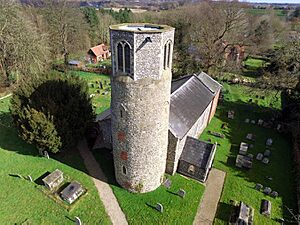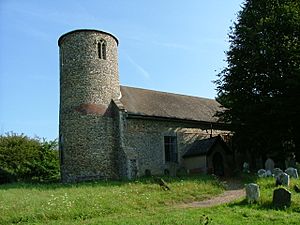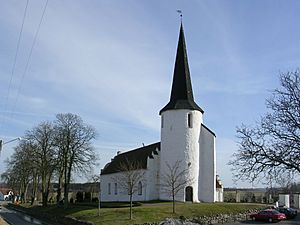Round-tower church facts for kids
Round-tower churches are a special kind of church building found mostly in England, especially in a region called East Anglia. Imagine a church where the bell tower isn't square or rectangular, but round! Out of about 185 of these unique churches left in England, most of them (124) are in Norfolk, and 38 are in Suffolk. You can also find a few in Essex, Sussex, Cambridgeshire, and Berkshire.
These round-tower churches aren't just in England! There are also about 20 similar ones in Germany. Other countries like Andorra, the Czech Republic, Denmark, France, Italy, Sweden, Norway, Poland, and South Africa also have at least one round-tower church.
It's important not to mix up these churches with other round buildings. For example, they are different from the Irish round towers you might see in Ireland and Scotland. They are also different from "round churches," which have a circular main building, often found in Denmark or Sweden.
Contents
Why Are They Round?
Experts aren't completely sure why so many churches in East England have round towers. Here are some of the main ideas:
Building Materials
One popular idea is about the building materials. In areas where these churches are found, there wasn't much normal stone for building. So, builders often used a material called flint. Flint is a hard stone that breaks into sharp pieces. It's quite tricky to build sharp corners with flint. Because of this, it was much easier to build thick, round walls for the towers.
Protection from Invaders
Another idea suggests that these churches were built in areas that faced attacks, for example, from the Vikings a long time ago. Some people think the towers were first built as strong, defensive structures, and then the church part was added later. However, this idea has some problems. The towers are usually not very tall, so they wouldn't have been super useful for defense. Also, many of these towers were added to churches that were already there, and they often have flat walls where they connect to the main church building.
King's Orders
A third idea points to a rule made by King Æthelstan in the year 937. King Æthelstan was the first King of all England. He ordered that every important landowner, called a thane, should build a bell tower on their land. This rule might have encouraged people to build bell towers onto their existing churches, and perhaps the round shape was just a popular style at the time.
Some local communities also have their own stories about why these towers are round, like connections to ancient stone circles or old wells, but these are less likely explanations.
Where to Find Round-Tower Churches in England
Most of England's round-tower churches are in East Anglia. Here's a look at some of the counties where you can find them:
Berkshire
- Great Shefford, St Mary
- Welford, St Gregory
Cambridgeshire
- Bartlow, St Mary
- Snailwell, St Peter
Essex
- Bardfield Saling, St Peter and St Paul
- Broomfield, St Mary
- Great Leighs, St Mary the Virgin
- Lamarsh, The Holy Innocents
- South Ockendon, St Nicholas of Myra
- Pentlow, St Gregory
Norfolk

Norfolk has the most round-tower churches in England. Here are just a few examples:
- Acle, St Edmund
- Ashmanhaugh, St Swithin
- Aslacton, St Michael
- Aylmerton, St John the Baptist
- Barmer, All Saints
- Bawburgh, St Mary and St Walstan
- Beachamwell, St Mary
- Bedingham, St Andrew
- Beeston, St Lawrence
- Belton, All Saints
- Bessingham, St Mary (formerly St Andrew)
- Bexwell, St Mary
- Bradwell, St Nicholas
- Brampton, St Peter
- Brandiston, St Nicholas
- Breckles, St Margaret
- Brooke, St Peter
- Buckenham, St Nicholas Church
- Burgh Castle, St Peter and St Paul
- Burnham Deepdale, St Mary
- Burnham Norton, St Margaret
- Bylaugh, St Mary
- Clippesby, St Peter
- Cockley Cley, All Saints
- Colney, St Andrew
- Cranwich, St Mary
- Croxton, All Saints
- Denton, St Mary
- Dilham, St Nicholas
- East Lexham, St Andrew
- East Walton, St Mary
- Eccles, St Mary
- Edingthorpe, All Saints
- Feltwell, St Nicholas
- Fishley, St Mary
- Forncett, St Peter's
- Framingham Earl, St Andrew
- Freethorpe, All Saints
- Fritton, St Catherine
- Fritton, St Edmund
- Gayton Thorpe, St Mary
- Geldeston, St Michael
- Gissing, St Mary
- Great Hautbois, St Mary
- Great Ryburgh, St Andrew
- Gresham, All Saints
- Haddiscoe, St Mary
- Hales, St Margaret
- Hardley, St Margaret
- Hardwick, St Margaret
- Hassingham, St Mary
- Haveringland, St Peter
- Heckingham, St Gregory
- Hellington, St John the Baptist
- Hemblington, All Saints
- Horsey, All Saints
- Howe, St Mary
- Ingworth, St Lawrence
- Intwood, All Saints
- Keswick, All Saints
- Kilverstone, St Andrew
- Kirby Cane, All Saints
- Letheringsett, St Andrew
- Little Plumstead, St Protase and St Gervase
- Little Snoring, St Andrew
- Long Stratton, St Mary
- Matlaske, St Peter
- Mautby, St Peter and St Paul
- Merton, St Peter
- Morningthorpe, St John the Baptist
- Morton on the Hill, St Margaret
- Moulton, St Mary
- Needham, St Peter
- St Benedict's Church, Norwich
- Norwich, St Etheldreda
- Norwich, St Julian
- Norwich, St Mary at Coslany
- Norton Subcourse, St Mary
- Old Catton, St Margaret
- Poringland, All Saints
- Potter Heigham, St Nicholas
- Quidenham, St Andrew
- Raveningham, St Andrew
- Repps-with-Bastwick, St Peter
- Rockland, St Peter
- Rollesby, St George
- Roughton, St Mary
- Roydon, St Remigus
- Runhall, All Saints
- Rushall, St Mary
- Sedgeford, St Mary
- Seething, St Margaret
- Shereford, St Nicholas
- Shimpling, St George
- Sidestrand, St Michael
- South Pickenham, All Saints
- Stanford, All Saints
- Stockton, St Michael
- Stody, St Mary
- Surlingham, St Mary
- Sustead, St Peter and St Paul
- Swainsthorpe, St Peter
- Syderstone, St Mary
- Tasburgh, St Mary
- Taverham, St Edmund
- Thorpe Abbotts, All Saints
- Thorpe next Haddiscoe, St Matthias
- Threxton, All Saints
- Thwaite, All Saints
- Titchwell, St Mary
- Topcroft, St Margaret
- Tuttington, St Peter and St Paul
- Wacton, All Saints
- Watton, St Mary
- Weeting, St Mary
- Welborne, All Saints
- West Dereham, St Andrew
- West Lexham, St Nicholas
- West Somerton, St Mary
- Whitlingham, St Andrew (tower collapsed)
- Wickmere, St Andrew
- Witton, St Margaret
- Woodton, All Saints
- Worthing, St Margaret
- Wramplingham, St Peter and St Paul
- Yaxham, St Peter
Suffolk

Suffolk also has many round-tower churches. Here are some of them:
- Aldham, St Mary
- Ashby, St Mary
- Barsham, Holy Trinity
- Beyton, All Saints
- Blundeston, St Mary
- Bramfield, St Andrew
- Brome, St Mary
- Bruisyard, St Peter
- Bungay, Holy Trinity
- Frostenden, All Saints
- Gisleham, Holy Trinity
- Gunton, St Peter
- Hasketon, St Andrew
- Church of St John Lateran, Hengrave
- Herringfleet, St Margaret
- Higham, St Stephen
- Holton, St Peter
- Ilketshall, St Andrew
- Ilketshall, St Margaret
- Little Bradley, All Saints
- Little Saxham, St Nicholas
- Lound, St John the Baptist
- Mettingham, All Saints
- Mutford, St Andrew
- Onehouse, St John the Baptist
- Ramsholt, All Saints
- Rickinghall Inferior, St Mary
- Risby, St Giles
- Rushmere, St Michael
- South Elmham, All Saints
- Spexhall, St Peter
- Stuston, All Saints
- Syleham, St Margaret
- Theberton, St Peter
- Thorington, St Peter
- Weybread, St Andrew
- Wissett, St Andrew
- Wortham, St Mary (This one is the largest round tower church still standing in England!)
Sussex
- Lewes, St Michael
- Piddinghoe, St John
- Southease, St Peter
Round-Tower Churches in Sweden
You can also find round-tower churches in other countries, like Sweden. Here are some examples from the Scania region:
Scania

- Blentarp
- Bollerup
- Dagstorp (This one was taken down in the 1800s)
- Hammarlöv
- Hammarlunda
- Önnarp (This one was also taken down in the 1800s)

